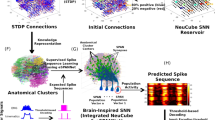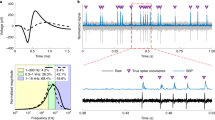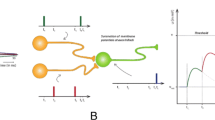Abstract
Decoding of sensorimotor information is essential for brain-computer interfaces (BCIs) as well as in normal functioning organisms. In this study, Bayesian models were developed for the prediction of binary decisions of 10 awake freely-moving male/female rats based on neural activity in a vibrotactile yes/no detection task. The vibrotactile stimuli were 40-Hz sinusoidal displacements (amplitude: 200 µm, duration: 0.5 s) applied on the glabrous skin. The task was to depress the right lever for stimulus detection and left lever for stimulus-off condition. Spike activity was recorded from 16-channel microwire arrays implanted in the hindlimb representation of primary somatosensory cortex (S1), overlapping also with the associated representation in the primary motor cortex (M1). Single-/multi-unit average spike rate (Rd) within the stimulus analysis window was used as the predictor of the stimulus state and the behavioral response at each trial based on a Bayesian network model. Due to high neural and psychophysical response variability for each rat and also across subjects, mean Rd was not correlated with hit and false alarm rates. Despite the fluctuations in the neural data, the Bayesian model for each rat generated moderately good accuracy (0.60–0.90) and good class prediction scores (recall, precision, F1) and was also tested with subsets of data (e.g. regular vs. fast spike groups). It was generally observed that the models were better for rats with lower psychophysical performance (lower sensitivity index A’). This suggests that Bayesian inference and similar machine learning techniques may be especially helpful during the training phase of BCIs or for rehabilitation with neuroprostheses.









Similar content being viewed by others
References
Ahissar, E., Sosnik, R., & Haidarliu, S. (2000). Transformation from temporal to rate coding in a somatosensory thalamocortical pathway. Nature, 406, 302–306.
Antonini, M. J., Sahasrabudhe, A., Tabet, A., Schwalm, M., Rosenfeld, D., Garwood, I., Park, J., Loke, G., Khudiyev, T., Kanik, M., Corbin, N., Canales, A., Jasanoff, A. P., Fink, Y., & Anikeeva, P. (2021). Customizing MRI-compatible multifunctional neural interfaces through Fiber drawing. Advanced functional materials, 31(43), 2104857. https://doi.org/10.1002/adfm.202104857
Applebaum, D. (1996). Probability and information: an integrated approach. Cambridge University Press.
Alpaydın, E. (2014). Introduction to machine learning (3rd ed.). MIT Press.
Andersen, R. A., Hwang, E. J., & Mulliken, G. H. (2010). Cognitive neural prosthetics. Annual Review of Psychology, 61, 169–190.
Baker, S. N., Spinks, R., Jackson, A., & Lemon, R. N. (2001). Synchronization in monkey motor cortex during a precision grip task. I. Task-dependent modulation in single-unit synchrony. Journal of Neurophysiology, 85, 869–885.
Barraclough, D. J., Conroy, M. L., & Lee, D. (2004). Prefrontal cortex and decision making in a mixed-strategy game. Nature Neuroscience, 7, 404–410.
Bernardo, J. M., & Smith, A. F. (2009). Bayesian theory (405 vol.). Wiley.
Boloori, A. R., Jenks, R. A., Desbordes, G., & Stanley, G. B. (2010). Encoding and decoding cortical representations of tactile features in the vibrissa system. Journal of Neuroscience, 30, 9990–10005.
Bowman, A. W., & Azzalini, A. (1997). Applied smoothing techniques for data analysis: the kernel approach with S-Plus illustrations. Clarendon Press; Oxford University Press.
Brockwell, A. E., Rojas, A. L., & Kass, R. E. (2004). Recursive bayesian decoding of motor cortical signals by particle filtering. Journal of Neurophysiology, 91, 1899–1907.
Bruno, R. M., & Simons, D. J. (2002). Feedforward mechanisms of excitatory and inhibitory cortical receptive fields. Journal of Neuroscience, 22, 10966–10975.
Callier, T., & Bensmaia, S. J. (2021). Restoring the sense of touch with electrical stimulation of the nerve and brain. In B. Güçlü (Ed.), Somatosensory feedback for neuroprosthetics (pp. 349–378). Academic.
Chapin, J. K., & Lin, C. S. (1984). Mapping the body representation in the SI cortex of anesthetized and awake rats. The Journal of Comparative Neurology, 229, 199–213.
Chapin, J. K., Moxon, K. A., Markowitz, R. S., & Nicolelis, M. A. L. (1999). Real-time control of a robot arm using simultaneously recorded neurons in the motor cortex. Nature Neuroscience, 2, 664–670.
Chaure, F. J., Rey, H. G., & Quiroga, R. Q. (2018). A novel and fully automatic spike-sorting implementation with variable number of features. Journal of Neurophysiology, 120, 1859–1871.
Chen, Z. (2013). An overview of bayesian methods for neural spike train analysis. Computational Intelligence and Neuroscience, 2013, 1–17. https://doi.org/10.1155/2013/251905
Devecioğlu, İ, & Güçlü, B. (2013). Asymmetric response properties of rapidly adapting mechanoreceptive fibers in the rat glabrous skin. Somatosensory and Motor Research, 30, 16–29.
Devecioğlu, İ, & Güçlü, B. (2015). A novel vibrotactile system for stimulating the glabrous skin of awake freely behaving rats during operant conditioning. Journal of Neuroscience Methods, 242, 41–51.
Doya, K., Ishii, S, Pouget, A., & Rao, RPN (Eds.). (2011). Bayesian brain: Probabilistic approaches to neural coding. MIT Press.
Feldman, N. H., Griffiths, T. L., & Morgan, J. L. (2009). The influence of categories on perception: explaining the perceptual magnet effect as optimal statistical inference. Psychological Review, 116, 752–782.
Fiorillo, C. D., Tobler, P. N., & Schultz, W. (2003). Discrete coding of reward probability and uncertainty by dopamine neurons. Science, 299, 1898–1902.
Gabernet, L., Jadhav, S. P., Feldman, D. E., Carandini, M., & Scanziani, M. (2005). Somatosensory integration controlled by dynamic thalamocortical feed-forward inhibition. Neuron, 48, 315–327.
Genovesio, A., Brasted, P. J., & Wise, S. P. (2006). Representation of future and previous spatial goals by separate neural populations in prefrontal cortex. Journal of Neuroscience, 26, 7305–7316.
Georgopoulos, A. P., Schwartz, A. B., & Kettner, R. E. (1986). Neuronal population coding of movement direction. Science, 233, 1416–1419.
Ghazanfar, A. A., Stambaugh, C. R., & Nicolelis, M. A. L. (2000). Encoding of tactile stimulus location by somatosensory thalamocortical ensembles. Journal of Neuroscience, 20, 3761–3775.
Greenspan, J. D., & Bolanowski, S. J. (1996). The psychophysics of tactile perception and its peripheral physiological basis. In L. Kruger (Ed.), Pain and touch (pp. 25–104). Academic Press.
Güçlü, B. (2021). Introduction to somatosensory neuroprostheses. In B. Güçlü (Ed.), Somatosensory feedback for neuroprosthetics (pp. 3–40). Academic Press.
Hasegawa, R. P., Hasegawa, Y. T., & Segraves, M. A. (2009). Neural mind reading of multi-dimensional decisions by monkey mid-brain activity. Neural Networks, 22, 1247–1256.
Hatsopoulos, N. G., & Suminski, A. J. (2011). Sensing with the motor cortex. Neuron, 72, 477–487.
Hernandez, A., Zainos, A., & Romo, R. (2000). Neuronal correlates of sensory discrimination in the somatosensory cortex. Proceedings of the National Academy of Sciences, 97, 6191–6196.
Hummelsheim, H., & Wiesendanger, M. (1985). Is the hindlimb representation of the rat’s cortex a “sensorimotor amalgam”? Brain Research, 346, 75–81.
Kloosterman, F., Layton, S. P., Chen, Z., & Wilson, M. A. (2014). Bayesian decoding using unsorted spikes in the rat hippocampus. Journal of Neurophysiology, 111(1), 217–227. https://doi.org/10.1152/jn.01046.2012
Laubach, M., Wessberg, J., & Nicolelis, M. A. (2000). Cortical ensemble activity increasingly predicts behaviour outcomes during learning of a motor task. Nature, 405, 567–571.
Liu, X., Wan, H., & Shi, L. (2014). Quality metrics of spike sorting using neighborhood components analysis. The Open Biomedical Engineering Journal, 8, 60–67.
Ma, W. J., Navalpakkam, V., Beck, J. M., Van Den Berg, R., & Pouget, A. (2011). Behavior and neural basis of near-optimal visual search. Nature Neuroscience, 14, 783–790.
Makalic, E., & Schmidt, D. F. (2016). High-dimensional Bayesian regularised regression with the BayesReg package. ArXiv:1611.06649.
Neafsey, E. J., Bold, E. L., Haas, G., Quirk, G., Sievert, C. F., & Terreberry, R. R. (1986). The organization of the rat motor cortex: a microstimulation mapping study. Brain Research Reviews, 11, 77–96.
Nicolelis, M. A. L., Ghazanfar, A. A., Stambaugh, C. R., Oliveira, L. M. O., Laubach, M., Chapin, J. K., Nelson, R. J., & Kaas, J. H. (1998). Simultaneous encoding of tactile information by three primate cortical areas. Nature Neuroscience, 1, 621–630.
Öztürk, S., & Güçlü, B. (2019). Predicting psychophysical response from multi-electrode spike recordings in rat SI cortex. Society for Neuroscience Abstracts, 45, 22114.
Pantoja, J., Ribeiro, S., Wiest, M., Soares, E., Gervasoni, D., Lemos, N. A., & Nicolelis, M. A. (2007). Neuronal activity in the primary somatosensory thalamocortical loop is modulated by reward contingency during tactile discrimination. Journal of Neuroscience, 27(39), 10608–10620.
Paxinos, G., & Watson, C. (2005). The rat brain in stereotaxic coordinates (5th ed.). Academic.
Petersen, R. S., Panzeri, S., & Diamond, M. E. (2002). Population coding in somatosensory cortex. Current Opinion in Neurobiology, 12, 441–447.
Pollack, I., & Norman, D. A. (1964). A non-parametric analysis of recognition experiments. Psychonomic Science, 1, 125–126.
Pouget, A., Dayan, P., & Zemel, R. (2000). Information processing with population codes. Nature Reviews Neuroscience, 1, 125–132.
Saal, H. P., & Bensmaia, S. J. (2014). Touch is a team effort: interplay of submodalities in cutaneous sensibility. Trends in Neurosciences, 37, 689–697.
Salinas, E., Hernandez, A., Zainos, A., & Romo, R. (2000). Periodicity and firing rate as candidate neural codes for the frequency of vibrotactile stimuli. Journal of Neuroscience, 20, 5503–5515.
Schmitzer-Torbert, N., Jackson, J., Henze, D., Harris, K., & Redish, A. D. (2005). Quantitative measures of cluster quality for use in extracellular recordings. Neuroscience, 131(1), 1–11.
Shaikhouni, A., Donoghue, J. P., & Hochberg, L. R. (2013). Somatosensory responses in a human motor cortex. Journal of Neurophysiology, 109, 2192–2204.
Silverman, B. W. (1998). Density estimation for statistics and data analysis. Chapman & Hall/CRC.
Sinclair, R. J., & Burton, H. (1991). Neuronal activity in the primary somatosensory cortex in monkeys (Macaca mulatta) during active touch of textured surface gratings: responses to groove width, applied force, and velocity of motion. Journal of Neurophysiology, 66, 153–169.
Suminski, A. J., Tkach, D. C., Fagg, A. H., & Hatsopoulos, N. G. (2010). Incorporating feedback from multiple sensory modalities enhances brain-machine interface control. Journal of Neuroscience, 30, 16777–16787.
Talbot, W. H., Darian-Smith, I., Kornhuber, H. H., & Mountcastle, V. B. (1968, Mar). The sense of flutter-vibration: comparison of the human capacity with response patterns of mechanoreceptive afferents from the monkey hand. Journal of Neurophysiology, 31, 301–334. https://doi.org/10.1152/jn.1968.31.2.301
Talwar, S. K., & Gerstein, G. L. (1999). A signal detection analysis of auditory-frequency discrimination in the rat. Journal of the Acoustic Society of America, 105, 1784–1800.
Vardar, B., & Güçlü, B. (2017). Non-NMDA receptor-mediated vibrotactile responses of neurons from the hindpaw representation in the rat SI cortex. Somatosensory and Motor Research, 34, 189–203.
Vardar, B., & Güçlü, B. (2020). Effects of basal forebrain stimulation on the vibrotactile responses of neurons from the hindpaw representation in the rat SI cortex. Brain Structure & Function, 225, 1761–1776.
Wessberg, J., Stambaugh, C. R., Kralik, J. D., Beck, P. D., Laubach, M., Chapin, J. K., Kim, J., Biggs, S. J., Srinivasan, M. A., & Nicolelis, M. A. (2000). Real-time prediction of hand trajectory by ensembles of cortical neurons in primates. Nature, 408, 361–365.
Wiest, M. C., Thomson, E., Pantoja, J., & Nicolelis, M. A. (2010). Changes in S1 neural responses during tactile discrimination learning. Journal of Neurophysiology, 104, 300–312.
Willis, W. D., & Coggeshall, R. E. (2004). Sensory mechanisms of the spinal cord (Vol. 1): Primary afferent neurons and the spinal dorsal horn. 3rd ed. Kluwer Academic/Plenum Publishers.
Wu, W., Gao, Y., Bienenstock, E., Donoghue, J. P., & Black, M. J. (2006). Bayesian population decoding of motor cortical activity using a Kalman filter. Neural Computation, 18, 80–118.
Zhang, K., Ginzburg, I., McNaughton, B. L., & Sejnowski, T. J. (1998). Interpreting neuronal population activity by reconstruction: unified framework with application to hippocampal place cells. Journal of Neurophysiology, 79, 1017–1044.
Zhu, J. J., & Connors, B. W. (1999). Intrinsic firing patterns and whisker-evoked synaptic responses of neurons in the rat barrel cortex. Journal of Neurophysiology, 81, 1171–1183.
Acknowledgements
This study was supported by TÜBİTAK Grant 117F481 within European Union’s FLAG-ERA JTC 2017 project GRAFIN and Boğaziçi University BAP no: 17XP2 given to Dr. Güçlü. We thank Bige Vardar, Deniz Kılınç, Utku Zeki Ortal for their help with experiments, and to Dr. Sinan Yıldırım for his clear explanations about Bayesian estimation.
Author information
Authors and Affiliations
Corresponding author
Ethics declarations
Conflict of interest
The authors declare no conflict of interest.
Additional information
Action Editor: Simon R Schultz
Publisher’s Note
Springer Nature remains neutral with regard to jurisdictional claims in published maps and institutional affiliations.
Supplementary information
Below is the link to the electronic supplementary material.
Table S1
Prediction of right (R) and left (L) lever responses by the Bayesian model. For each rat, class prediction scores (recall (RE), precision (PR) and F1 score) are calculated based on true positive (TP), false negative (FN), false positive (FP) and true negative (TN) pooled counts. Class averaged scores and accuracies (ACC) are also given. Last three rows report, respectively, subject means, standard deviations, and performance scores for subject-pooled data. (DOCX 16.8 KB)
Table S2
Prediction of correct (C) and incorrect (I) responses by the Bayesian model based on subject-pooled data. Similar to Table S1, class prediction scores are given as recall (RE), precision (PR) and F1 score. Class-averaged scores and accuracies (ACC) are also given. (DOCX 16.9 KB)
Table S3
Psychophysical performances of biological, simulated (R/L classifier model), and augmented (C/I classifier model) subjects. Probabilities of hits (pH), false alarms (pH), non-parametric sensitivity (A’) and bias (B’’) indices are given. The last two rows are subject means and standard deviations. (DOCX 15.7 KB)
Rights and permissions
Springer Nature or its licensor (e.g. a society or other partner) holds exclusive rights to this article under a publishing agreement with the author(s) or other rightsholder(s); author self-archiving of the accepted manuscript version of this article is solely governed by the terms of such publishing agreement and applicable law.
About this article
Cite this article
Öztürk, S., Devecioğlu, İ. & Güçlü, B. Bayesian prediction of psychophysical detection responses from spike activity in the rat sensorimotor cortex. J Comput Neurosci 51, 207–222 (2023). https://doi.org/10.1007/s10827-023-00844-0
Received:
Revised:
Accepted:
Published:
Issue Date:
DOI: https://doi.org/10.1007/s10827-023-00844-0




